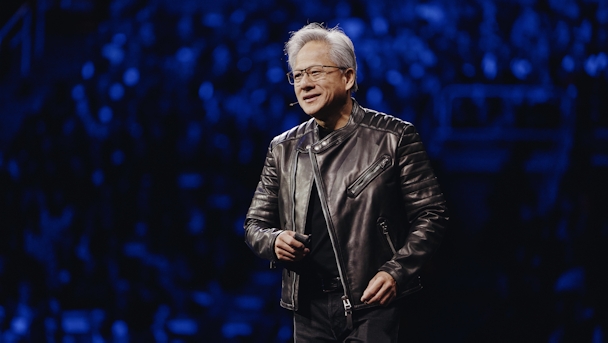When marketers hear “GPU developer conference,” it rarely sparks excitement. But Nvidia’s GTC is no ordinary tech meet-up – it’s where the biggest AI breakthroughs are unveiled, setting the agenda for industries far beyond Silicon Valley.
Jensen Huang delivering his keynote / Nvidia
At this year’s Nvidia GPU Technology Conference, the keynote by chief exec Jensen Huang was stacked with announcements that could shift how brands create, communicate and connect. Here’s how the marketing world could feel the impact.
- AI tools that actually “get” your customers: Nvidia’s new Blackwell Ultra platform lets AI reason more like humans. Expect sharper virtual assistants, recommendation engines and ad targeting that feels less like code and more like a conversation.
- Budget-friendly AI campaigns: The Dynamo open-source framework cuts the time and cost of deploying AI models at scale. Marketers will be able to roll out AI-driven campaigns and customer tools faster – and more cheaply.
- Google’s new AI wingman: Nvidia and Google are developing agentic AI – tech that can take independent actions. For agencies, that could mean autonomous creative testing, customer research bots or AI media planners.
- Oracle brings AI to the enterprise: Nvidia’s Oracle partnership will supercharge enterprise software with faster AI inference. Think sharper customer insights, speedier automation and more powerful data tools built into everyday workflows.
- Lower cloud bills incoming: Nvidia’s tie-up with storage leaders will make AI infrastructure cheaper and more efficient. That means reduced production costs for data-heavy work – from audience modeling to creative renders.
- Infinite scale for AI factories: Nvidia’s Spectrum-X networking tech can now link millions of GPUs – unlocking faster generative media, accelerated CGI and shorter lead times for content production.
- DIY AI supercomputers: The DGX SuperPOD is an enterprise AI factory you can install out-of-the-box. For publishers or creative studios, it’s a new route to building custom generative AI models without relying on third parties.
- Quantum computing for marketers: Nvidia’s quantum research center is laying the groundwork for breakthroughs in adtech – real-time bidding, predictive analytics and next-gen optimization could all get faster and smarter.
- Open-source AI agents: A new wave of open AI reasoning models will make it easier for brands to create intelligent assistants, customer-facing bots and internal AI tools without blowing the budget.
- Hyperlocal weather data for events: Nvidia’s Earth-2 digital twin of the planet is now being used to improve weather prediction. For marketers running live events or outdoor activations, this could mean fewer weather surprises.
- AI-powered customer service bots: Nvidia’s Isaac Gr00t N1 is the first open humanoid robot foundation model. It’s still early days, but the in-store robot assistant is now a tangible prospect.
- Omniverse is scaling up: Nvidia’s Omniverse AI OS is expanding across more industries. Marketers could soon use it to build 3D worlds, virtual showrooms and immersive branded experiences – more easily and at scale.
- Virtual prototypes made simple: The Cosmos world foundation models will help brands build virtual products and test spaces faster. Ideal for creative prototyping, e-commerce trials or experiential pitches.
- Smarter in-car media: Through a partnership with General Motors, Nvidia is helping to create AI-powered in-vehicle experiences – future media spaces where tailored brand content could live.
- AI’s role in healthcare marketing: With GE HealthCare, Nvidia is advancing autonomous diagnostic imaging. For healthcare marketers, this could lead to new ways to visualize campaigns, case studies or data-driven stories.
- AI on your desktop: DGX Spark and DGX Station are Nvidia’s new personal AI rigs. For creative teams, that means faster AI-driven editing, generative design and smart automation – right from your desk.
- Workstations that design faster: The Blackwell RTX PRO series brings AI horsepower to studios and agencies. Expect accelerated rendering, smarter workflows and AI that works seamlessly with designers and developers.
- Ready for 6G-powered marketing: Nvidia and telecom leaders are building AI-native wireless networks for 6G. This could unlock real-time AR/VR activations, richer mobile campaigns and seamless global content delivery.
- AI behind the counter: Nvidia is teaming up with Yum! Brands to transform fast food operations. It’s a move that could also improve loyalty programs, customer engagement and personalization – we’ve already seen Taco Bell leverage tech to improve the customer experience.
- AI factories for every brand: Nvidia’s AI factory blueprints could help brands build internal AI production pipelines – automating content creation, customer service and even insight generation.
The Drum’s take
Jensen Huang’s announcements show that AI is moving from the backroom to the boardroom. For marketers, it’s no longer about keeping up – it’s about getting ahead, whether that’s building in-house AI studios or rethinking how campaigns are created and delivered.

